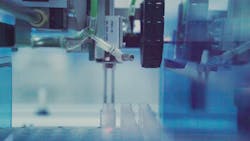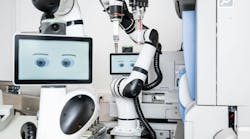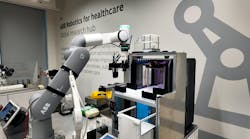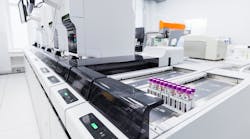Clinical chemistry encompasses centralized analytical activity concerning the chemical composition of biological material necessary for the diagnosis and treatment of research into diseases.1 The discipline, which originated in small laboratories with relatively few manual tests performed, now requires highly automated and integrated laboratories to produce hundreds of thousands of body fluid specimens every day to be analyzed, with the data obtained being interpreted with the end goal of assessing the health of patients.2
The transition from manual to automated testing began in 1875, when Thaddeus M. Stevens, MD, Professor of Analytical Chemistry at the College of Physicians and Surgeons of Indiana, created the first semi-automated device to be mentioned in American chemical literature. The device was designed to drip water through a piece of filter paper at a controlled rate to wash a filtrate and was an introductory insight into the ideas and techniques that would revolutionize clinical chemistry over the next century.3 Furthermore, in 1956 Leonard Skeggs developed the AutoAnalyzer, the first practical and completely automated system designed to meet the specific needs of a clinical chemistry laboratory. The system performed blood analysis from start to finish without manual intervention by a technologist and provided new advantages, such as less labor, fast analysis, and the use of screening panels.4
Since the launch of the AutoAnalyzer, successful generations of stand-alone analyzers have continued to be popular within the clinical chemistry industry. The variety of systems available, many of which differ in terms of throughput volume, physical features, analytical speed and size of test menu, means that there is now an automated system widely available to suit the needs of the vast majority of laboratories worldwide.
Why automation transformed clinical testing
In modern times, automated testing systems have become increasingly popular, allowing users to transform their output amongst other perceived benefits, such as less labor required, decreased preparation time, and fewer input errors. Ultimately, the primary difference between automatic and manual systems is that in a manual system, a human tester is required on-site to provide the input for processes to run successfully.5
When considering the effectiveness of some of the above perceived benefits, I will refer to research carried out by Danyel Hermes Tacker, PhD, who completed a study, which involved processing 20 batches containing 5-90 specimens, each using both methods in parallel and randomly across a 4-week period.6
In Tacker’s study, he identified 45 steps involved in the entire specimen-testing process. Of the multitiude of manual steps, Tacker believed that a vast majority of the manual steps could easily become automated if an up-to-date system was used. This emphasizes the ability of an automated system to take on more of the workload during the testing process, which as a result, reduces the requirement for as much human labor within the laboratory setting. Therefore, if the machinery can share a greater amount of the task, laboratories will be able to reduce labor costs due to a decrease in demand for human expertise on-site.
Furthermore, Tacker’s study also found a significant reduction in batch preparation time when an automated system was used in comparison to a manual testing system. In a batch containing 60 specimens, technologists took 145 minutes to prepare the specimens for testing, while the automated system took just 97 minutes. Following a similar pattern, a batch of 90 specimens took 184 minutes when prepared manually, compared to 97 minutes when automated. If a batch can be prepared for testing at a faster rate, this will allow for greater levels of operational efficiency and productivity. This means the laboratory can produce more test results each day because less time is being taken to prepare each batch.
Finally, a major advantage of automated systems is that, as a result of less human interaction with the process, there is likely to be a reduced number of errors. During Tacker’s study, the technologists involved reported fatigue caused by moderate and persistent discomfort in the hands, neck and shoulders when processing high batch numbers. In addition to this finding, it was the multitude of tedius steps, which can be automated, that caused technologists the most discomfort. Therefore, it can be concluded that during a manual testing process, physical fatigue limits the ability to efficiently process batches containing a high quantity of specimens. As an automated system limits human input, fatigue will be reduced to the point whereby it may be non-existent, meaning that more reliable results can be produced.
The future of testing
One thing that is for certain is that automation continues to be the future of chemistry testing. Those within the science industry are constantly seeking to further innovate new technologies to improve productivity and efficiency within laboratories that strive to produce accurate results as fast as possible. Furthermore, as technology develops and fresh ideas enter the market, the automation of today will likely filter down into smaller laboratories, thus continuing the growth of an automated world of testing.
Perhaps the most common assumption regarding the future of testing within the laboratory is the birth of robotic lab assistants (robots). This shift began at the start of the millennium, with robots being introduced to laboratory settings to carry out previously manual tasks, such as manipulating samples, applying chemicals that aid the process of breaking up DNA into measurable segments, analyzing results, and feeding these results into a computer.7 A study by the University of Liverpool in 2020, where a robotic lab assistant machine was created, found that a robot operated approximately 1,000 times faster than a human over the course of a working week.8 The robot was in operation for 22 hours on each of the seven days, something that is simply not feasible when using human input without the uptake of high labor costs. Although robotic assistants create a common fear that there will no longer be a requirement for any human input, this is not true. The machine created by the University of Liverpool required programming and couldn’t physically set up its own experiments.8 This development will act as a major benefit within laboratories in the future, as while the robotic assistant carries out the tedious, time consuming tasks, scientists will have more time to carry out new research, which would not be possible in the present time.
As new automated technology becomes available in the future, it is likely that we will see a ‘trickle down’ effect with systems becoming more accessible and affordable to laboratories that differ in size and budget. In the past, limited supply and high costs meant that automated technology was often reserved for the benefit of the best funded laboratories around the globe.9 However, as the demand for automated machinery continues long term, an increase in supply – in addition to the larger laboratories seeking the latest innovations – will result in an increasingly wide range of automated testing across smaller laboratories, medical centers, schools and universities. As this occurs, the number of laboratories depending solely on manual testing will further decrease, continuing the automated revolution to clinical testing.
Conclusion
In conclusion, we have witnessed a monumental shift in favor of automation since the work of Leonard Skeggs in 1956. Although this shift is not unique to the science industry, with much of the world favoring new technology over techniques and processes of the past, automated systems offer a range of benefits to both laboratories and the scientists who work there. Less preparation time, faster throughput and reduced human error mean that testing is now more efficient than ever before, improving results in faster times and, in-turn, making testing a more profitable exercise due to increased output. While some see the introduction of robotic assistants as a threat to employment, it is deemed highly unlikely that laboratories will ever be fully able to function without human input. Therefore, the additional helping hand will reduce fatigue and bodily strain amongst those working in the laboratory, allowing for more time to conduct new research, which will again lead to new findings and further develop capabilities in the future.
References
- Reeve, J, Twomey, P and Borovickova, I. 2021. The role of the clinical chemistry laboratory in facilitating earlier diagnosis of dyslipidaemia-associated inherited metabolic disease. J Clin Pathol. 2020;73(7):363-365. doi:10.1136/jclinpath-2019-206254.
- Kricka, L. and Savory, J., 2011. International year of chemistry 2011: A guide to the history of clinical chemistry. Clin Chem. 2011;57(8):1118-1126. doi:10.1373/clinchem.2011.165233
- Olsen, K., 2012. The first 110 years of laboratory automation. J Lab Autom. 2012;17(6):469-480. doi:10.1177/2211068212455631.
- Armbruster DA, Overcash DR, Reyes J. Clinical chemistry laboratory automation in the 21st century - Amat Victoria curam (Victory loves careful preparation). Clin Biochem Rev. 2014;35(3):143-153.
- Guru99.com. 2021. Automation testing vs. manual testing: What’s the difference? https://www.guru99.com/difference-automated-vs-manual-testing.html. Accessed 29 April 2021.
- Tacker D, Topardo J, Mahaffey C, Perrotta P. Workflow analysis comparing manual and automated specimen processing for mass spectrometry–based Vitamin D testing. Lab Med. 2014; 45(4), pp.361-367. doi: 10.1309/LMZL47EN6KDODMXJ Abstract
- Edwards C. Medical robotics: the end of the lab technician? E&T. https://eandt.theiet.org/content/articles/2014/11/medical-robotics-the-end-of-the-lab-technician/. Published November 10, 2014. Accessed April 29, 2021.
- Vincent J. Robotic lab assistant is 1,000 times faster at conducting research. The Verge. https://www.theverge.com/21317052/mobile-autonomous-robot-lab-assistant-research-speed. Published July 8, 2020. Accessed April 29, 2021.
- Valinreja. The Past, Present & Future of Lab Automation. Bio Molecular Systems. https://biomolecularsystems.com/the-past-present-future-of-lab-automation/. Published March 9, 2021. Accessed April 29, 2021.





